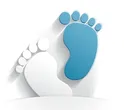THE 26TH MILE
By Doug Milch, DPM
RUNNING INJURIES
One thing is certain with running. Injuries will occur. How long they keep you out of action and what you can do about them is key. What follows is a list of common running injuries and what you can do to get back on the road.
A BLISTER is a collection of fluid under the skin that occurs due to friction. It happens when a shoe or sock rubs the foot. Prevention consists of good shoe and sock fit. Treatment consists of cleansing the area and using a sterile needle to puncture the blister to allow it to drain. Apply antibiotic ointment and a band-aid. Change the shoe or sock that caused it. Prior to actual blister formation, a "hot spot" occurs which is a pre-blister. Apply moleskin or other padding and change the shoe or sock.
A SHIN SPLINT is inflammation of the lower leg where muscles originate. They are due to excessive stress or pulling at the muscle insertion. They can be anterior, medial, or lateral. They are caused by hard surfaces and/or poor shoes, muscle imbalances, and training error. Treatment consists of ice, stretching and strengthening, decreased mileage, different shoes, and orthotics, taping, and ankle/leg bracing.
PLANTAR FASCIITIS/HEEL PAIN is an inflammation of the plantar fascia which is a fibrous band on the bottom of the foot that runs from the heel along the arch and into the ball of the foot. It occurs from excessive traction or pulling which happens when a runner has a tight fascia or a pronated foot. The pain is worse with initial weight bearing in the morning and after running. Treatment consists of calf stretching, anti-inflammatory, proper shoes, and orthotic inserts.
BLACK TOENAILS are caused by bleeding under the toenails which occurs from repeated microtrauma of the toe hitting the end of the shoe. It is caused by shoes that are too short, and the condition is aggravated by downhill running. Treatment consists of trimming the nails and wearing proper fitting shoes.
RUNNER’S KNEE is pain that occurs about the medial knee area due to abnormal tracking of the patella (kneecap). This can be due to poor shoes, excessive foot pronation, and weak quadriceps muscles. Treatment consists of decreasing mileage, ice and anti-inflammatory, selective quadriceps muscle strengthening, better shoes, and orthotic inserts.
ILIOTIBIAL BAND FRICTION SYNDROME is pain about the lateral aspect of the knee due to friction on the Iliotibial band which is a structure that runs from the outside of the hip towards the lateral knee region. Treatment consists of ice and anti-inflammatory, stretching, decreased mileage, and different shoes and/or orthotics.
A STRESS FRACTURE is a break of a bone due to repeated microtrauma from overuse that causes the bone to crack. Stress fractures cause pain and swelling. They are usually due to training error of doing too much too soon, excessive mileage, hard surfaces, or poor shoes. Treatment for stress fractures includes no running, doing alternative exercises to maintain conditioning, better shoes, and training alterations. Stress fractures usually heal in about 6 weeks.
ACHILLES TENDINITIS is inflammation of the Achilles tendon. This results in pain and swelling of the tendon usually 4 to 6 centimeters above the insertion into the heel. It can be caused by a tight Achilles, abnormal foot motion, poor shoes, and running hills. Treatment consists of ice and anti-inflammatory, stretching, heel lifts, orthotics, different shoes, decreasing mileage, and avoiding hills.
A WORD ABOUT RUNNING INJURIES
Don’t be too discouraged if an injury occurs. During the injury phase, you may become filled with self-doubt and despair, and you wonder if you will ever get better. The good news is that almost all do heal and you will run once again. In the meantime, walk, swim, cycle, or lift weights. Hang in there and repeat after me, "This too shall pass."
A WORD ABOUT ORTHOTICS
Orthotics are inserts that go inside running shoes. They can be off the shelf or custom made. There are many off the shelf inserts that are excellent. It is often a good idea to start off with this type.
Custom inserts are made specifically for that person’s feet through some type of an impression. They can be full or 3/4 length, and they can be made from a variety of materials. It is not important who makes the orthotics or what they look like. What matters is that they comfortable and that they work. Not everyone needs orthotics, but those who do, won’t give them up.
